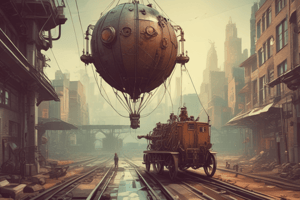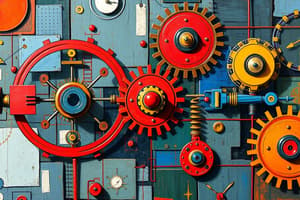Podcast
Questions and Answers
What is the main function of a lever?
What is the main function of a lever?
- To reduce friction
- To increase the speed of an object
- To change the direction or magnitude of a force (correct)
- To lift heavy objects
What type of pulley is attached to a fixed object?
What type of pulley is attached to a fixed object?
- Compound pulley
- Movable pulley
- Simple pulley
- Fixed pulley (correct)
What is the advantage of using a wheel and axle?
What is the advantage of using a wheel and axle?
- It lifts heavy objects
- It changes the direction of a force
- It increases the force applied
- It reduces friction and increases speed (correct)
What is the main characteristic of an inclined plane?
What is the main characteristic of an inclined plane?
What is the main purpose of a wedge?
What is the main purpose of a wedge?
What is an example of a first-class lever?
What is an example of a first-class lever?
What is the mechanical advantage of an inclined plane?
What is the mechanical advantage of an inclined plane?
What is an example of a movable pulley?
What is an example of a movable pulley?
What type of lever has the load between the effort and fulcrum?
What type of lever has the load between the effort and fulcrum?
What is the primary purpose of calculating mechanical advantage in a machine?
What is the primary purpose of calculating mechanical advantage in a machine?
What is the unit of measurement for work?
What is the unit of measurement for work?
What is the difference between ideal mechanical advantage and actual mechanical advantage?
What is the difference between ideal mechanical advantage and actual mechanical advantage?
Which of the following statements is true about efficiency?
Which of the following statements is true about efficiency?
What is the formula to calculate the work done by a force?
What is the formula to calculate the work done by a force?
What is the importance of mechanical advantage in machines?
What is the importance of mechanical advantage in machines?
What is the purpose of calculating the efficiency of a machine?
What is the purpose of calculating the efficiency of a machine?
Flashcards are hidden until you start studying
Study Notes
Simple Machines
Lever
- A lever is a rigid bar or beam that pivots around a fixed point (fulcrum)
- Used to change the direction or magnitude of a force
- Three types of levers:
- First-class lever: fulcrum is between the effort and load
- Second-class lever: load is between the effort and fulcrum
- Third-class lever: effort is between the fulcrum and load
- Examples: seesaw, crowbar, scissors
Pulley
- A pulley is a wheel with a grooved rim and a rope or cable wrapped around it
- Used to change the direction of a force or to gain a mechanical advantage
- Two types of pulleys:
- Fixed pulley: attached to a fixed object
- Movable pulley: attached to the load
- Examples: elevator, crane, block and tackle
Wheel and Axle
- A wheel and axle is a circular object that rotates around a fixed axis (axle)
- Used to reduce friction and increase speed
- Examples: bicycle, car, wheelbarrow
Inclined Plane
- An inclined plane is a flat surface that is tilted at an angle
- Used to lift or move heavy objects with less effort
- Examples: ramp, staircase, inclined conveyor belt
- Mechanical advantage: increases the force applied, but decreases the distance over which the force is applied
Wedge
- A wedge is a triangular-shaped object that is used to split, separate, or lift objects
- Used to apply a large force to a small area
- Examples: knife, axe, doorstop, zipper
- Mechanical advantage: increases the force applied, but decreases the distance over which the force is applied
Simple Machines
Lever
- Rigid bar or beam that pivots around a fixed point (fulcrum) to change direction or magnitude of a force
- Three types: first-class (fulcrum between effort and load), second-class (load between effort and fulcrum), and third-class (effort between fulcrum and load)
- Examples: seesaw, crowbar, scissors
Pulley
- Wheel with grooved rim and rope or cable wrapped around it to change direction of force or gain mechanical advantage
- Two types: fixed (attached to fixed object) and movable (attached to load)
- Examples: elevator, crane, block and tackle
Wheel and Axle
- Circular object rotating around fixed axis (axle) to reduce friction and increase speed
- Examples: bicycle, car, wheelbarrow
Inclined Plane
- Flat surface tilted at an angle to lift or move heavy objects with less effort
- Mechanical advantage: increases force applied, but decreases distance over which force is applied
- Examples: ramp, staircase, inclined conveyor belt
Wedge
- Triangular-shaped object to split, separate, or lift objects by applying large force to small area
- Mechanical advantage: increases force applied, but decreases distance over which force is applied
- Examples: knife, axe, doorstop, zipper
Mechanical Advantage
- Mechanical Advantage (MA) is the ratio of output force to input force in a machine
- Formula: MA = Output Force / Input Force
- There are two types of Mechanical Advantage:
- Ideal Mechanical Advantage (IMA): Theoretical MA, assuming no energy loss
- Actual Mechanical Advantage (AMA): Real-world MA, considering energy loss
- Importance: Increases force, speed, or distance, making work easier
Work and Efficiency
Work
- Work is the transfer of energy from one object to another through a force applied over a distance
- Formula: W = F x d
- Unit: Joule (J)
Efficiency
- Efficiency is the ratio of output energy to input energy
- Formula: η = Output Energy / Input Energy
- Unit: Percentage (%)
- Importance: High efficiency means less energy wasted as heat
Energy Transformation in Simple Machines
- Simple machines transform energy from one form to another
- Energy transformation occurs in three stages:
- Input energy is applied to the machine
- Energy is transformed and amplified through the machine
- Output energy is produced, performing the desired task
Studying That Suits You
Use AI to generate personalized quizzes and flashcards to suit your learning preferences.




